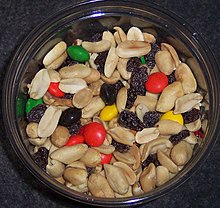
| Part of a series on |
| Meals |
|---|
 |
| Meals |
| Components and courses |
| Related concepts |
A snack is a small portion of food generally eaten between meals. A snack is often less than 200 calories, but this can vary. Snacks come in a variety of forms including packaged snack foods and other processed foods, as well as items made from fresh ingredients at home.
Traditionally, snacks are prepared from a number of ingredients commonly available at home without a great deal of preparation. Often cold cuts, fruits, leftovers, nuts, sandwiches, and sweets are used as snacks. With the spread of convenience stores, packaged snack foods became a significantly profitable business.
Snack foods are typically designed to be portable, quick, and satisfying. Processed snack foods, as one form of convenience food, are designed to be less perishable, more durable, and more portable than prepared foods. They often contain substantial amounts of sweeteners, preservatives, and appealing ingredients such as chocolate, peanuts, and specially designed flavors (such as flavored potato chips). Aside from the use of additives, the viability of packaging so that food quality can be preserved without degradation is also important for commercialization.
A snack eaten shortly before going to bed or during the night may be called a "bedtime snack", "late night snack", or "midnight snack".
Asia
India
Main article: List of snack foods from the Indian subcontinentIndian snack foods are typically called chaats. Snacks like pani puri and samosas have become popular outside of India.
Most traditional snacks are home-made or sold by street vendors. Haldiram's is one of the top-selling and famous Indian snack brands around the world.
Indonesia
Kue
Main article: kue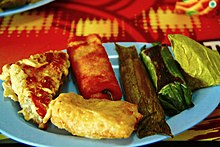
Indonesia has a rich collection of snacks called kue (cakes and pastry), both savoury and sweet. Traditional kue is usually made from rice flour, coconut milk, and coconut sugar, and is mostly steamed or fried rather than baked. Traditional kue are popularly known as kue basah ("wet kue") that has a moist, soft texture because of rich coconut milk. Kue kering (dried kue) is the local name for cookies. Indonesia has several variations of kue, both native and foreign-influenced.
Traditional crackers
Main articles: krupuk and kripik
Traditional crackers are called krupuk, made from bits of shrimp, fish, vegetables or nuts, which are usually consumed as a crunchy snack or an accompaniment to meals. These crispy snacks are sometimes added to main dishes for their crunchy texture; several Indonesian dishes such as gado-gado, karedok, ketoprak, lontong sayur, nasi uduk, asinan and bubur ayam are known to require specific types of krupuk as toppings. There are wide variations of krupuk available across Indonesia. The most popular ones would be krupuk udang (prawn crackers) and krupuk kampung or krupuk putih (cassava crackers).
Other popular types include krupuk kulit (dried buffalo-skin crackers), emping melinjo (gnetum gnemon crackers), and kripik (chips/crisps), such as kripik pisang (banana chips) and keripik singkong (Cassava chips). Rempeyek is a flour-based cracker with brittle of peanuts, anchovies or shrimp bound by a crispy flour cracker. Rengginang or intip (Javanese) is a rice cracker made from sun-dried and deep fried leftover rice.
Japan
Main article: List of Japanese snacksJapan has a very wide range of snack foods, some of which are internationally popular, ranging from onigiri to melon pan.
Malaysia
- Cincin - a deep fried dough pastry-based snack popular with East Malaysia's Muslim communities.
- Roti john - a spiced meat omelette sandwich, popularly eaten for breakfast or as a snack.
- Bakkwa (Chinese : 肉干) - literally "dried meat", bakkwa is better understood as barbecued meat jerky. While this delicacy is especially popular during the Chinese New Year celebration period, it is available everywhere and eaten year round as a popular snack.
- Idli - made from a mashed mixture of skinned black lentils and rice formed into patties using a mould and steamed, idlis are eaten at breakfast or as a snack. Idlis are usually served in pairs with vadai, small donut-shaped fritters made from mashed lentils and spices, chutney, and a thick stew of lentils and vegetables called sambar.
- Murukku - a savoury snack of spiced crunchy twists made from rice and urad dal flour, traditionally eaten for Deepavali in South India.
- Vadai, vada or vades - is a common term for many different types of savoury fritter-type snacks originated from South India with a set of common ingredients. The most common ingredients are lentils, chillis, onions and curry leaves.
- Tebaloi - is a sago biscuit snack which is traditionally associated with the Melanau people of Sarawak.
- Pisang goreng - a common snack sold by street vendors, battered fried bananas are also served in a more elaborate manner at some cafes and restaurants as a dessert. Cempedak and various tuber vegetables are also battered and fried in the same manner as variations.
Taiwan
- Taro ball - a traditional Taiwanese cuisine dessert made of taro.
- Suncake (Taiwan) - is a popular Taiwanese dessert originally from the city of Taichung, Taiwan.
- Aiyu jelly - is a jelly made from the gel from the seeds of the awkeotsang creeping fig found in Taiwan.
- Pineapple cake - is a sweet traditional Taiwanese pastry containing butter, flour, egg, milk powder, sugar, and pineapple paste or slices.
Thailand
- Miang kham – dried shrimp and other ingredients wrapped in cha plu leaves; often eaten as a snack or a starter.
- Sai ua – a grilled sausage of ground pork mixed with spices and herbs; it is often served with chopped fresh ginger and chilies at a meal. It is sold at markets in Chiang Mai as a snack.
North America
Canada
In 2010, the average Canadian ate 300 snacks. Canadian identity is often associated with snack foods that are sold in Canada due to economic nationalism. Some Canadian snacks include ketchup chips, Smarties, Coffee Crisp, Kinder Surprise, Jos Louis, Big Turk, and Nanaimo bars.
United States
In the United States, a popular snack food is the peanut. Peanuts first arrived from South America via slave ships and became incorporated into African-inspired cooking on southern plantations. After the Civil War, the taste for peanuts spread north, where they were incorporated into the culture of such popular events as baseball games and vaudeville theaters.
Along with popcorn (also of South American origin), snacks bore the stigma of being sold by unhygienic street vendors. The middle-class etiquette of the Victorian era (1837–1901) categorized any food that did not require proper usage of utensils as lower-class.
Pretzels were introduced to North America by the Dutch, via New Amsterdam in the 17th century. In the 1860s, the snack was still associated with immigrants, unhygienic street vendors, and saloons. Due to loss of business during the Prohibition era (1920–1933), pretzels underwent rebranding to make them more appealing to the public. As packaging revolutionized snack foods, allowing sellers to reduce contamination risk, while making it easy to advertise brands with a logo, pretzels boomed in popularity, bringing many other types of snack foods with it. By the 1950s, snacking had become an all-American pastime, becoming an internationally recognized emblem of middle American life.
Middle East
Nuts are a staple of snacks in the Middle East. Among the many varieties available within the region, the most popular are almonds, walnuts, hazelnuts, pine nuts, and pistachios. According to archeological evidence, nuts have been part of the Middle Eastern diet for centuries with ancient civilizations taking advantage of them for their health benefits. The health benefits of nuts comes from them being good sources of protein, healthy fats, fibers, vitamins and minerals. Nuts have now become a regular snack with a 119 billion dollar market as of 2022 that is projected to continue growing into 2023. Nuts can be prepared in a variety of ways, such as by roasting them with spices and lemon juice or incorporating them into food and desserts such as baklava, knafeh, and kibbeh.
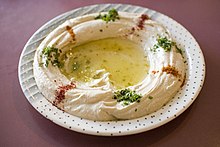
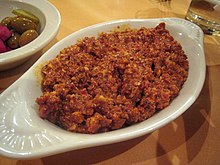
Spreads and dips are eaten with pita bread. The most popular dip in the middle east is hummus. Hummus is a blend of chickpeas, tahini, lemon, and garlic usually served with olive oil and paprika on top. Hummus's origins can be traced back to a Syrian cookbook from the 13th century. Other dips are also popularly served such as mouhammara and baba ganoush. Mouhammara is a walnut, tahini, and roasted red pepper dip served with olive oil on top originating from the Syrian city of Aleppo. Baba ganoush is a spread made from roasted eggplants, olive oil, and other vegetables. The origins of baba ganoush are not clear with many conflicting pieces of evidence pointing to multiple countries of origin. A sweet dip is Ashta, a cream made from milk, rose or orange blossom water, and ghee, which is usually accompanied with honey.

Many popular snacks in the Middle East are obtained from street vendors due to low cost and convenience of eating on the go. Many of these snacks consist of a protein with bread. Falafel consists of many little fried balls of ground chickpeas or fava beans with herbs, spices served in pita bread with tahini sauce and a choice of vegetables. Falafel is believed to originate from Egypt around 1000 years ago by Egyptian Copts. Shawarma is served in a similar fashion to falafel, pita bread with sauce and vegetables, but instead prepared by slowly cooking layers of meat on a spit before thinly slicing it.
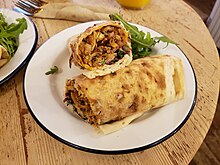
Nutrition
| The examples and perspective in this article may not represent a worldwide view of the subject. You may improve this article, discuss the issue on the talk page, or create a new article, as appropriate. (April 2023) (Learn how and when to remove this message) |
Government bodies, such as Health Canada, recommend that people make a conscious effort to eat more healthy, natural snacks, such as fruit, vegetables, nuts, and cereal grains while avoiding high-calorie, low-nutrient junk food.
A 2010 study showed that children in the United States snacked on average six times per day, approximately twice as often as American children in the 1970s. This represents consumption of roughly 570 calories more per day than U.S. children consumed in the 1970s.
Types
Further information: List of snack foods- Bagel with cream cheese
- Bitterballen
- Candy bar
- Carrot Chips
- Chaat
- Cheese, a larger cold prepared snack
- Cheese puffs/cheese curls
- Chocolate-coated marshmallow treats
- Corn chips and Tortilla chips
- Cocktail sausage
- Cookies
- Crackers
- Deviled eggs
- Doughnuts
- Dried fruits
- Drinkable yogurt
- Edamame, fresh or dried
- Granola bars
- Falafel
- Flour tortilla with a filling
- Frozen berries
- Fruit, whole, sliced, Fruit salad, Fruit cocktail
- Ice cream
- Jell-O
- Jerky
- Kaassoufflé
- Latiao
- Lunchables
- Milkshake
- Muffins
- Nuts
- Pound cake
- Papadum
- Peanuts
- Pita bread
- Popcorn
- Pork rinds
- Potato chips
- Pakoda
- Pretzels
- Raisins
- Ratatouille
- Rice cake
- Rice crackers, distinguished from the above
- Samosa
- Seeds
- Shortbread
- Smoked salmon
- Smoothie
- Teacake
- Trail mix
- Vegetables (e.g., carrots, celery, cherry tomatoes)
- Yogurt
Image gallery
-
 Irachikkaya
Irachikkaya
-
A rack of Chip (snack)
-
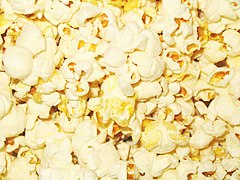 Popcorn
Popcorn
-
 Trail mix
Trail mix
-
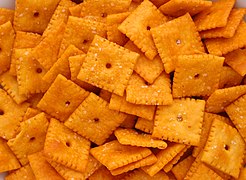 Cheez-It, a popular cheese-flavored cracker
Cheez-It, a popular cheese-flavored cracker
-
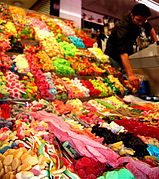 Candy
Candy
-
Snickers, a popular chocolate bar
-
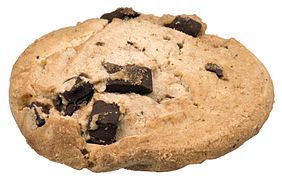 Chocolate chip cookie
Chocolate chip cookie
-
 Fruit
Fruit
-
 Pączki
Pączki
-
 Potato chips
Potato chips
-
 Pretzels
Pretzels
-
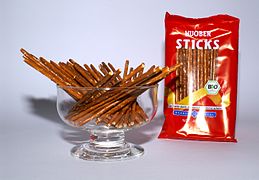 Pretzel sticks
Pretzel sticks
-
 Doughnuts
Doughnuts
-
 A blueberry muffin
A blueberry muffin
-
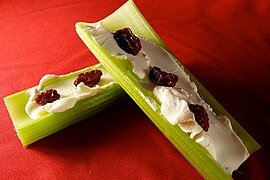 Ants on a log
Ants on a log
-
 Dutch bitterballen
Dutch bitterballen
-
 Peanuts
Peanuts
-
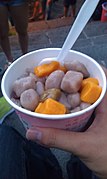 Taro ball
Taro ball
-
 Aiyu jelly
Aiyu jelly
-
Pineapple cake
See also
- Canapés
- Junk food
- List of brand name snack foods
- List of foods
- List of Indian snack foods
- List of Indonesian snacks
- List of Japanese snacks
- List of snack foods
- List of snack foods by country
- Savoury (dish)
References
- "Snack". Dictionary.com. Archived from the original on 4 March 2016. Retrieved 13 March 2011.
- Racco, Marilisa. "This is what your breakfast, lunch and dinner calories actually look like". Global News. Retrieved 29 July 2017.
- Willhoft, Edward M.A. (1990). "Packaging for the Preservation of Snack Food". Booth, R.G. (eds) Snack Food: 349-371. doi:10.1007/978-1-4613-1477-6_18.
- Heinz Von Holzen; Lother Arsana (2015). Food of Indonesia: Delicious Recipes from Bali, Java and the Spice Islands. Tuttle Publishing. ISBN 9781462914913.
- "The making of Tebaloi". Sarawak Tourism Board. Archived from the original on 8 November 2022. Retrieved 7 June 2015.
- Thiessen 2017, p. 12.
- Goodman, Rob (2023). Why American Democracy Is Eroding and How Canada Can Protect Itself. Simon & Schuster. p. 175. ISBN 9781668012451.
- Thiessen 2017, p. 30.
- Skinner, RJ. "7 Canadian snacks you can't get in the U.S. and the backstory on why". CBC Life. Retrieved 9 August 2024.
- ^ Carroll, Abigail (30 August 2013). "How Snacking Became Respectable". Wall Street Journal. ISSN 0099-9660. Archived from the original on 21 December 2019. Retrieved 29 May 2016.
- "America: just one long snack bar". Ellensburg Daily Record. 3 April 1973. Archived from the original on 8 November 2022. Retrieved 14 December 2018 – via Google News.
- Casas-Agustench, Patricia; Salas-Huetos, Albert; Salas-Salvadó, Jordi (December 2011). "Mediterranean nuts: origins, ancient medicinal benefits and symbolism". Public Health Nutrition. 14 (12A): 2296–2301. doi:10.1017/S1368980011002540. ISSN 1475-2727. PMID 22166187. S2CID 36384880.
- Casas-Agustench, Patricia; Salas-Huetos, Albert; Salas-Salvadó, Jordi (December 2011). "Mediterranean nuts: origins, ancient medicinal benefits and symbolism". Public Health Nutrition. 14 (12A): 2296–2301. doi:10.1017/S1368980011002540. ISSN 1475-2727. PMID 22166187. S2CID 36384880.
- Services, Department of Health & Human. "Nuts and seeds". www.betterhealth.vic.gov.au. Retrieved 6 October 2023.
- ltd, Market Data Forecast. "MEA Nuts and Seeds Market | 2022 to 2027 | UAE, Israel, KSA, South Africa, Egypt". Market Data Forecast. Retrieved 6 October 2023.
- Bergum, Vidar (11 December 2020). "Middle Eastern spiced nuts". A kitchen in Istanbul. Retrieved 6 October 2023.
- Kravchuk, Natasha (21 December 2014). "Baklava Recipe, Honey Baklava, How to Make Best Baklava". NatashasKitchen.com. Retrieved 6 October 2023.
- Mueller, Elizabeth (Beth) (5 October 2018). "Knafeh". Pear Tree Kitchen. Retrieved 6 October 2023.
- ^ "Middle Eastern dips and spreads to bump hummus off your summer menu". Chicago Tribune. 1 August 2019. Retrieved 6 October 2023.
- Karadsheh, Suzy (20 April 2020). "BEST Classic Hummus Recipe you'll find!". The Mediterranean Dish. Retrieved 6 October 2023.
- Shaheen, Kareem (24 March 2023). "The True Origins of Hummus". New Lines Magazine. Retrieved 6 October 2023.
- Karadsheh, Suzy (29 May 2020). "Muhammara Recipe (Roasted Red Pepper Dip)". The Mediterranean Dish. Retrieved 6 October 2023.
- Kate (17 October 2017). "Epic Baba Ganoush". Cookie and Kate. Retrieved 6 October 2023.
- Lamoureux, Aimee (13 January 2023). "The Literal Meaning Of 'Baba Ganoush' Is Hilarious". The Daily Meal. Retrieved 6 October 2023.
- Alphafoodie, Samira @ (25 October 2021). "Easy Kashta/Ashta (Lebanese Clotted Cream)". Alphafoodie. Retrieved 6 October 2023.
- ^ Bremner, Jade (12 July 2017). "20 top Middle Eastern foods: Which is the best?". CNN. Retrieved 9 October 2023.
- Karadsheh, Suzy (6 February 2020). "Easy Authentic Falafel Recipe: Step-by-Step". The Mediterranean Dish. Retrieved 9 October 2023.
- admin (8 December 2021). "The History of Falafel". Export IL. Retrieved 9 October 2023.
- Nagi (6 February 2022). "Chicken Shawarma (Middle Eastern)". RecipeTin Eats. Retrieved 9 October 2023.
- "Smart Snacking - Canada's Food Guide". Health Canada. Archived from the original on 14 April 2011. Retrieved 13 March 2011.
- "New Trend Shows Kids Snacking Every Few Hours". NPR. Archived from the original on 10 February 2011. Retrieved 11 March 2010.
- "American Diet Then and Now: How Snacking Is Expanding the Country's Waistline - ABC News". ABC News. Archived from the original on 5 March 2016. Retrieved 20 February 2016.
Sources
- Thiessen, Janis (2017). Snacks: A Canadian Food History. University of Manitoba Press. ISBN 9780887555275.
| Meals | |
|---|---|
| Common meals | |
| Components and courses | |
| Table service | |
| Presentation | |
| Dining | |
| Regional styles | |
| Packed | |
| Menus and meal deals | |
| Communal meals | |
| Catering and food delivery | |
| Places to eat | |
| Related | |